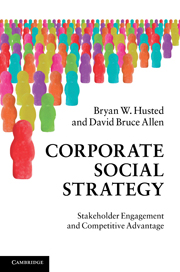Book contents
- Frontmatter
- Contents
- Figures
- Tables
- Acknowledgments
- 1 Introduction
- Part I Fundamentals
- 2 Is corporate social strategy ethical?
- 3 Theory of the firm and corporate social strategy
- 4 How do we build corporate social strategy?
- 5 Elements of successful corporate social strategy
- Part II The process of developing corporate social strategy
- Part III Implementing social strategy
- Bibliography
- Index
3 - Theory of the firm and corporate social strategy
Published online by Cambridge University Press: 05 June 2012
- Frontmatter
- Contents
- Figures
- Tables
- Acknowledgments
- 1 Introduction
- Part I Fundamentals
- 2 Is corporate social strategy ethical?
- 3 Theory of the firm and corporate social strategy
- 4 How do we build corporate social strategy?
- 5 Elements of successful corporate social strategy
- Part II The process of developing corporate social strategy
- Part III Implementing social strategy
- Bibliography
- Index
Summary
The theory of the firm is ultimately concerned with the purpose of the firm itself. Neoclassical economic theory has generally taken profit or shareholder value maximization as the appropriate objective of the firm (Jensen, 2002; Sundaram and Inkpen, 2004). A strategic approach to corporate social action does not dispute this basic objective. Now some may claim that firms should maximize both profits and social performance. Although social strategy is focused on understanding the conditions under which profit maximization and social performance are congruent, we face an important constraint noted by Jensen (2002: 238) who indicated that it is “logically impossible to maximize in more than one dimension at the same time unless the dimensions are monotone transformations of one another.” This constraint implies that profits and social performance cannot be maximized simultaneously. In other words, there is a trade-off between profits and social performance, except in the special case where they mutually reinforce each other. Jensen’s exception points to situations in which it may be possible to achieve both objectives at the same time – investment in corporate social projects needs to contribute to profit maximization. Our challenge is to determine the conditions that this requirement imposes upon social projects.
The discipline of economics has looked at these questions in terms of the private provision of public goods (Demsetz, 1970; Keim, 1978; Thoreen, 1981; Baron, 2001). McWilliams and Siegel (2001) have recently discussed the supply and demand conditions that would lead to optimal investment in social projects by the firm. Using the tools of microeconomic analysis, this chapter explores the conditions under which firm investment in social initiatives is consistent with shareholder value maximization, and in so doing points to an avenue for research and practice that may in fact be quite promising. It also sketches some ideas about the advisability of the firm making investments to solve social problems and about the optimal amount of social output to be produced by the firm. We develop this argument by looking at three different cases: the firm as altruist, as coerced egoist, and as strategist. In each case, we consider both the benefits obtained by the firm from its social projects as well as their costs.
- Type
- Chapter
- Information
- Corporate Social StrategyStakeholder Engagement and Competitive Advantage, pp. 48 - 63Publisher: Cambridge University PressPrint publication year: 2010



